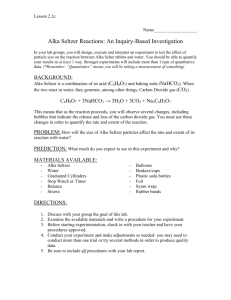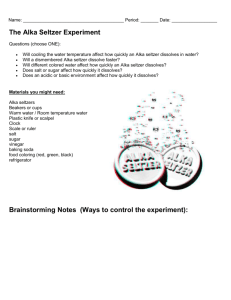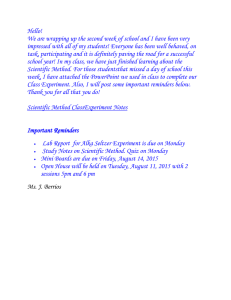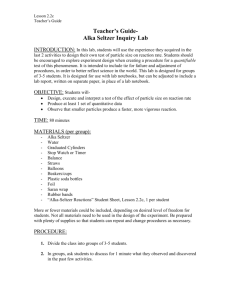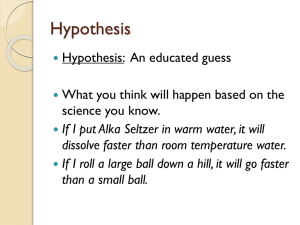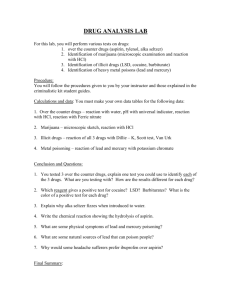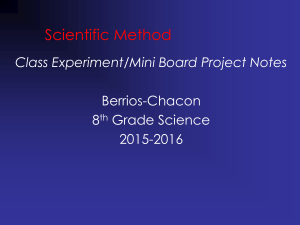PASCO Probe Lab Chemical Reactions: Orange Juice and Alka
advertisement
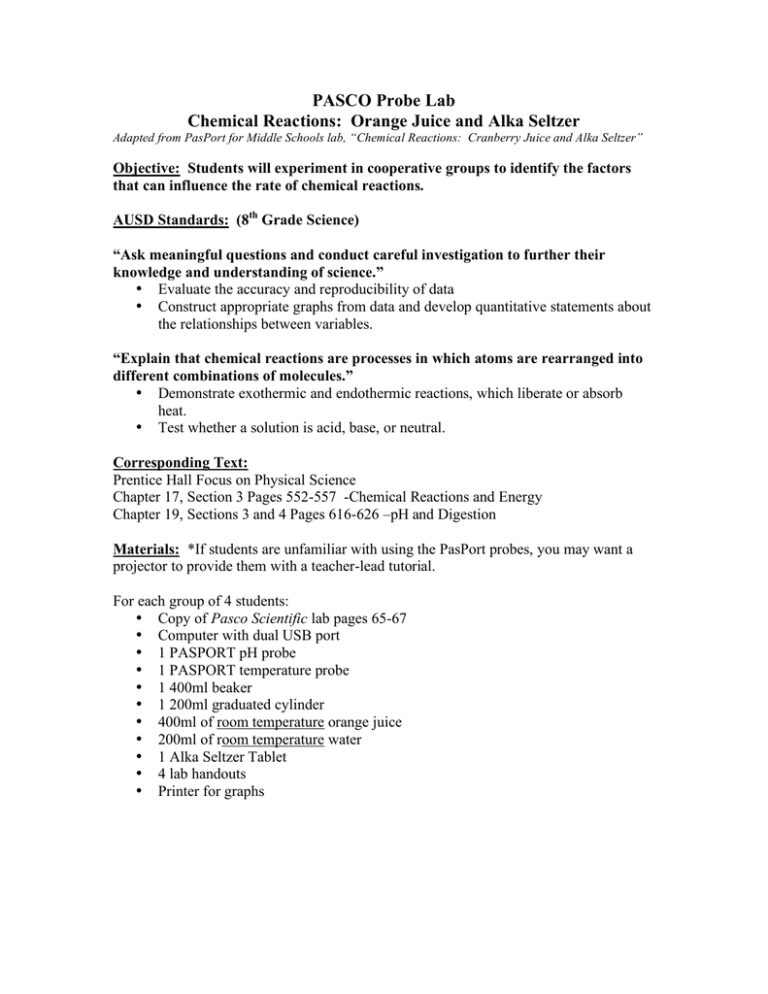
PASCO Probe Lab Chemical Reactions: Orange Juice and Alka Seltzer Adapted from PasPort for Middle Schools lab, “Chemical Reactions: Cranberry Juice and Alka Seltzer” Objective: Students will experiment in cooperative groups to identify the factors that can influence the rate of chemical reactions. AUSD Standards: (8th Grade Science) “Ask meaningful questions and conduct careful investigation to further their knowledge and understanding of science.” • Evaluate the accuracy and reproducibility of data • Construct appropriate graphs from data and develop quantitative statements about the relationships between variables. “Explain that chemical reactions are processes in which atoms are rearranged into different combinations of molecules.” • Demonstrate exothermic and endothermic reactions, which liberate or absorb heat. • Test whether a solution is acid, base, or neutral. Corresponding Text: Prentice Hall Focus on Physical Science Chapter 17, Section 3 Pages 552-557 -Chemical Reactions and Energy Chapter 19, Sections 3 and 4 Pages 616-626 –pH and Digestion Materials: *If students are unfamiliar with using the PasPort probes, you may want a projector to provide them with a teacher-lead tutorial. For each group of 4 students: • Copy of Pasco Scientific lab pages 65-67 • Computer with dual USB port • 1 PASPORT pH probe • 1 PASPORT temperature probe • 1 400ml beaker • 1 200ml graduated cylinder • 400ml of room temperature orange juice • 200ml of room temperature water • 1 Alka Seltzer Tablet • 4 lab handouts • Printer for graphs Lab Procedure: Day 1: Data Gathering You will need no fewer than four groups of four students. Each student group will be assigned one of four possible trials. Students will complete their trials and answer the conclusion questions for part 1 on the student lab handout. Day 2: Data Analysis and Conclusions Students will continue to work in their lab groups and will share the results of their trial with the class. Students will then be able to answer the conclusion questions on part 2 of the student lab handout Classroom Procedure: Students will work in groups of 4 scientists for every one lab station. For lab station setup, see “Materials”. Each student scientist will be assigned one of 4 possible roles. Each role and its lab responsibilities are listed below. • • • • Computer Technician- Responsible for connecting the probes to the USB ports and for operating the computer. Must also notify the “Mixture Monitor”, “Temperature Supervisor” and “pH operator” of time. Clean-up: Shut down computer and return laptop to cart (if necessary). Mixture Monitor- Responsible for measuring out liquid and diluting solution if necessary. Also must add Alka Seltzer tablet to mixture when instructed by the “Computer Technician”. Clean-up: Rinse out beaker and wipe down table. Temperature Supervisor- Responsible for running the temperature probe. Must place the probe in liquid at appropriate time and must keep probe out of the way of Alka Seltzer addition. Needs to ensure that probe remains upright and in the liquid for the duration of the trial. Clean-up: Rinse temperature probe and return to case. pH Operator- Responsible for running the pH probe. Must place the probe in liquid at appropriate time and must keep probe out of the way of Alka Seltzer addition. Needs to ensure that probe remains upright and in the liquid for the duration of the trial. Clean-up: Rinse pH probe, replace buffer cap and return probe to case. *All students will record their results and observations on their own lab handout. Each group of four students will be assigned one of the four possible trials outlines below. You will need at least 4 groups of 4 in order to analyze all of the variables. • • • • Trial 1- 100% Orange Juice (400ml) and Whole Alka Seltzer Tablet Trial 2- 50% Orange Juice (200ml) solution diluted with water (200ml) and Whole Alka Seltzer Tablet Trial 3- 100% Orange Juice (400ml) and Crushed Alka Seltzer Tablet Trial 4- 50% Orange Juice (200ml) solution diluted with water (200ml) and Crushed Alka Seltzer Tablet Sample Graphic Results: Trial #1 100% OJ and Whole Alka Seltzer Trial #2 50% OJ Solution and Whole Alka Seltzer Trial #3 100% OJ and Crushed Alka Seltzer Trial #4 50% OJ Solution and Crushed Alka Seltzer Summary of expected results: Students should find that the reaction taking place is endothermic (the temperature of the solution should drop). Students should also observe an increase in the pH of the solution as the Alka Seltzer neutralizes the acidic orange juice. Both of these changes should be more amplified when the surface area of the reactant in increased (crushed Alka Seltzer) and when the concentration of the reactant in increased (pure OJ versus weaker diluted solution).
